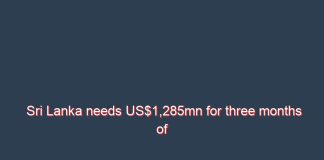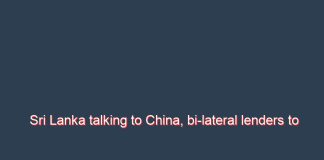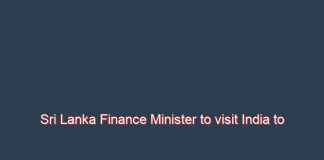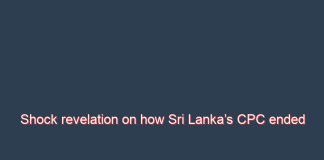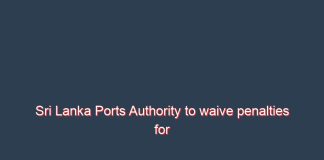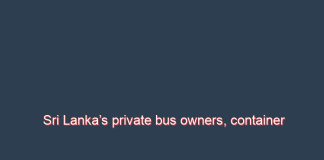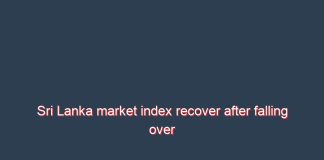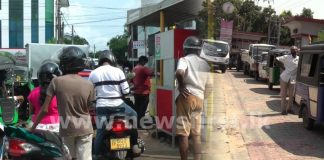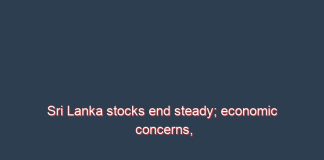Sri Lanka needs US$1,285mn for three months of oil, US$500mn from...
ECONOMYNEXT – Sri Lanka needs 1,285 million US dollar for oil imports in the next three months, of which 500 million will come from an Indian credit line, Energy Minister Udaya Gammanpila said, as the country grappled with forex shortages and global prices went up.
“For the next three months we have forecasted 1,285.5 million US dollars for oil imports,” Energy Minister Udaya Gammanpila said.
“We hope to get 500 million dollars from the credit line from India. We are talking to others we will tell parliament when we finalize them.”
The 500 million dollar credit line to be activated in April is a one year facility at 2.5 percent.
India this month gave consignment of diesel on an appeal by Sri Lanka ahead of the credit line being used officially.
He said oil prices were around 40 to 45 US dollars a barrel in 2020, about 55 to 65 in 2021 are around 90 to 100 million dollars in 2022 so far with Russian invasion of Ukraine pushing prices up, he said.
Brent crude had moved up to 101.40 dollars as he spoke.
As of February 24, Sri Lanka had following stocks of fuel:
Petrol 92 – for 10 days
Petrol 95 -for 40 days
Lanka Auto Diesel 08 days
Super Diesel – 8 days
From a ship that is now being unloaded 5000 metric tonnes of diesel would be given to the Ceylon Electricity Board and 4,200 MT to the Sojitz power plant, which would be enough to run it for six days, he said.
“Some stocks are also coming in the future,” he said.
Each week two to three ship come based on the projected fuel needs of the country, based on which tenders have been floated. However unloading of tankers have been delayed due to forex shortages.
Sri Lanka usually has stocks for 15 to 21 days before the forex crisis, Energy Ministry Secretary K D Olga has said.
Sri Lanka has been struggling to find foreign exchange to pay for oil with liquidity injections being made to keep interest rates down after giving reserves for imports.
When foreign reserves of a pegged central bank (which are savings) are given for imports, an equivalent fall in rupee reserves must take place in commercial banks to keep the economy in balance.
However in a pegged central bank with a policy rates, money is printed an re-inserted to banking system (sterilized reserve sale) preventing a correction in credit, the balance of payments and driving imports and economic activity to an unsustainable level.
Sri Lanka is now trying to get credit lines for fuel, instead of market pricing and offsetting domestic consumption and non-oil imports.
Credit lines (domestic consumption financed by foreign borrowings) will further widen the external current account deficit and national debt.
The Mercantilists who print money or finances budget deficits with foreign borrowings and state enterprises with credit lines then jump up and say there is a current account deficit or a ‘twin deficit’ in a country where private citizens are net savers. (Colombo/Feb25/2022)
Sri Lanka talking to China, bi-lateral lenders to reprofile debt: Minister
ECONOMYNEXT – Sri Lanka is talking to China and several other bi-lateral lenders to reprofile debt, State Minister for Samurdhi and micro-finance Shehan Semasinghe said as the country grapples with a worsening foreign exchange crisis amid liquidity injections.
“We have initiated talks with China and several other countries to reprofile debt,” Minister Semasinghe told parliament. “These talks are becoming successful.”
Reprofiling is a term used to describe debt where the maturity is extended without a hair cut.
China has in the past generally given new loans to pay installments falling due.
Sri Lanka is also talking to banks in the Middle East for facilities worth 2 billion US dollars, Minister Semasinghe said.
Related
Sri Lanka in talks with Middle East banks for US$2bn: Minister
Sri Lanka Finance Minister to visit India to discuss billion dollars of credit lines
Finance Minister Basil Rajapaksa will also visit India shortly for further talks on credit lines for a billion US dollar credit line. A 500 million US dollar credit line for fuel is to be activated from April.
Sri Lanka’s forex reserves have been falling amid liquidity injections made to keep rates low, as the domestic economy was unable to generate the savings from inflows to finance maturing debt.
In October the central bank began to give ‘reserves for imports’ enforcing a peg at 200 for trade, further depleting remaining reserves and forcing it to print money to sterilise interventions to maintain a policy rate. (Colombo/Feb25/2022)
Sri Lanka Finance Minister to visit India to discuss billion dollars...
ECONOMYNEXT – Sri Lanka’s Finance Minister Basil Rajapaksa will visit India soon to wrap up credit lines worth a billion US dollars, State Minister for Samurdhi and micro finance Shehan Semasinghe said.
“We are ready to enter into several agreements with India for financial facilities worth a billion US dollars,” Minister Semasinghe told parliament.
“We have made arrangement for the Finance Minister to visit India within a very short time to discuss this.”
India is expected to give credit lines worth a billion US dollars to Sri Lanka to import food and medicines.
Sri Lanka is in a severe foreign exchange crisis, due to money printed to maintain artificially low interest rates as budget deficits expanded and the private credit recovered from a Coronavirus crisis.
Sri Lanka has faced forex crises, since a money printing central bank was set up in 1950, and has engaged in failed Mercantilist solutions solve monetary instability without brining laws to restrict the discretionary powers of a soft-pegged central bank to manipulate interest rates.
Everytime money is printed, injecting excess demand to the domestic economy, which spills over to the balance of payments, credit lines and loans are taken to import oil in particular.
India is expected to sign a 500 million US dollar credit line for oil in April. India has already given a 400 million US dollar swap to the central bank and deferred payments on a regional clearing arrangement.
The Mercantilists then complain that the external current account deficit is widening.
Sri Lanka frequently goes to the International Monetary Fund, which force the country to raise rates, reduce the deficit, and float the currency but no lasting solution in the form of central bank restraint is done, making the country get into forex trouble as soon as credit economy recovers in the next cycle. (Colombo/Feb25/2022)
Shock revelation on how Sri Lanka’s CPC ended up with billions...
ECONOMYNEXT – Shocking details of how state-run Ceylon Petroleum Corporation, which has no foreign exchange revenues to speak of ended up with billions of US dollars of debt every time the central bank printed money to create forex shortages has now been revealed.
Sri Lanka has been engaging in a long time practice of barring the CPC from buying dollars, even if the firm collected rupees from market-pricing oil, every time the central bank printed money and created currency pressure. Instead, the corporation was forced to borrow dollars.
Analysts have dubbed the policy blunder which leads to tens of billions of rupees in losses every time the rupee falls, a Nick Leeson type of action, named after a derivative dealer who had unhedged position.
K D R Olga, Secretary to the Ministry of Energy has now revealed how the policy blunder took place and CPC did not buy oil with rupees despite having rupees in its bank accounts collected rupees from customers.
The central bank recently asked the CPC to find the rupees from customers and pay for oil instead of running losses and financing them with bank credit adding to debt and interest rate pressure in the country.
Anardimuth Practice
“This is not practice (kra-mer-vey-dher-yer) that prevailed all this time,” K D R Olga, Secretary to the Ministry of Energy revealed in a talk show hosted by Sri Lanka’s privately-run Hiru TV.
“For many, many years (anar-di-muth kar-ler-yer-ker si-tter), that is not what happened. It has now come to a crunch (hira wellar thi-yenar prush-ner-yer).”
“For many years when we (CPC) was not in a financial crisis, we bought oil on a credit basis. We have imported oil even on 360-day credit.”
Olga said the CPC bought oil on 360-day credit, 270-day credit, 180-day and 90-day credit.
“That was the time when we had a good balance sheet,” she explained. “The oil was imported on a letter of credit.
“When the letter of credit fell due, in order to maintain a stable exchange rate, instead of settling it – even when the CPC had rupees in its accounts – that was turned into a dollar debt.
“The two state banks will settle the LC and turn it into a debt of the Ceylon Petroleum Corporation. That has turned into a dollar debt of over three billion US dollars.”
Olga said the CPC debt in rupee terms was now around 750 billion rupees (3.7 billion US dollars).
Who is the Nick Leeson?
Olga did not say who ordered the CPC which has no dollar revenues to speak of (except some aviation oil sales), to either import oil on suppliers credit or turn them into debt.
However analysts have shown that every time the central bank ran inflationary policy (printed money despite having a pegged exchange) and created currency pressure, the CPC dollar debt went up.
Analysts have dubbed these un-hedged dollar exposures a Nick Leeson type of financial blunder.
Authorities have not only indebted the CPC to banks but the country had also borrowed from other nations to buy oil.
Sri Lanka has an outstanding loan from Iran over oil purchased during a currency crisis decades past.
State banks either paid the dollars with their NRFC deposits, or had to borrow the dollars from other parties and the CPC at a margin.
The CPC is now planning to get a 500 million US dollar credit line from India.
When imports are financed by a financial account inflow the external current account deficit widens.
Sri Lanka’s Mercantilists, then jump up and say there is an external current account deficit or a “twin deficit” and blame it for the country’s economic woes, critics say.
Nick Leeson Losses
The CPC also makes a massive forex loss every time the rupee falls.
Economists and analysts have long called for market pricing of oil so that customers of petroleum utilities pay the higher price, which will reduce their disposable incomes to make non-oil imports.
Critics have pointed out that in 2018, when then Finance Minister Mangala Samaraweera market priced oil through a price formula, the central bank printed money to target an output gap and created forex shortages, the CPC was against forced to borrow.
However the practice of borrowing dollars sabotages the entire price formula.
In the 2018 currency crisis the CPC placed the money in state banks via repurchase agreements, which were in turn loaned to other customers who made non-oil imports.
In 2018, the CPC made an 80 billion rupee forex loss. It also has to keep paying interest on fuel which has long been sold, sometimes at a profit.
Officials have said in 2021 the CPC made a loss of 83 billion rupees. How much of this is due to forex depreciation and interest on the Nick Leeson loans is not known.
When the rupee falls in 2022, the CPC will also make large losses.
The central bank has said that state banks are endangered by CPC borrowings and asked the CPC to collect rupees from customers and pay for the dollars.
Now suppliers are no longer willing to give CPC credit, with Sri Lanka’s sovereign credit downgraded to ‘CC’.
“Now suppliers only give oil to us if we pay upfront (kalin mudal gew-woth),” Olga said. “The payment for tomorrows ship has to be made. For that the needed rupees the CPC has prepared.”
However the cabinet of ministers this week had decided not to increase fuel prices.
If the losses are financed by credit, Sri Lanka’s interest rates will have to go up further.
If money is printed to keep rates down or the state-banks borrow from the central bank standing liquidity facility to finance the CPC loss, further foreign exchange pressure and reserve losses will take place, taking Sri Lanka closer to default, analysts warn. (Colombo/Feb24/2022)
Sri Lanka Ports Authority to waive penalties for delayed containers as...
ECONOMYNEXT – The Sri Lanka Ports Authority (SLPA) is in the process of waiving demurrage charged on containers at the SLPA-owned Colombo port after importers failed to clear them on time amid forex shortage, officials said.
‘’We are still at the primary stage of examining documents and we are still not sure about the amount that will be waived off,” a senior SLPA official told EconomyNext on Tuesday (23).
“We can’t even be sure of the exact number of requested waivers as we have received many in a short period.’’
The island nation’s main port saw hundreds of containers stuck in its dockyards as importers struggled to clear them because they could not open letters of credit or secure adequate US dollars.
The government has given priority to clearing essential food containers to avert a possible food shortage and arbitrary price increase in essential commodities amid higher demand.
The SLPA has already called for documentary evidence to review the eligibility for waivers, as a special concession to importers, towards cargo landed at SLPA-owned terminals (JCT & ECT) pending clearance up to January 31, 2022, in the wake of the prevalent foreign exchange situation.
The SLPA has said “some number of consignments [are] lying uncleared over a significant period of time”.
Importers have complained of no US dollars to clear their imported containers since the last quarter of 2021.
“The individuals have to bring in documents from the bank to prove that they could not pay the fees due to the forex crisis,” another senior SLPA official told EconomyNext.
“Every day we get many documents, and we are working to get them all processed. We are giving preference to food items like rice, sugar, and so on.”
Neither official commented on the total number of containers stuck in the port but claimed that it was not 2,000 as reported in media.
‘That it is not true. At any given time there are a lot of containers coming and going from the dockyards. I don’t know from where these figures went to the media, but there is no such problem.’’
In January 2019, only 10.10 percent of cargo remained in the dockyards for over a week. In January this year, the figure has increased to 11.59 percent. SLPA officers said, ‘There’s an increase but not as drastic as reported, and it is not even worth mentioning.’’
“At this time we were made aware that we don’t need to earn a super profit and charge unnecessary charges to take advantage of this crisis. So the decision to remove the demurrage and penal costs were made while thinking of the importers.’’ (Colombo/Feb23/2022)
Sri Lanka power cuts, fuel shortages, expose forex crisis – EXPLAINER
ECONOMYNEXT – Sri Lanka on Wednesday made a 35.3 million US dollar payment to release a 37,500 metric tonne diesel shipment and President Gotabaya Rajapaksa has also asked authorities to give priority for fuel as power cuts became bigger.
Energy Minister Udaya Gammanpila who had earlier has earlier warned of four hour power cuts when daily power cuts were denied to the CEB after a coal plant broke down, forex shortages disrupted imports and the utility was running down hydro storage too fast.
Gammanpila has also warned of fuel shortages if the CPC is not allowed a price increase to generate rupees to buy dollars as it can no longer borrow from banks.
Here are some key questions and answers on the fuel crisis in Sri Lanka:
Why is Sri Lanka facing a fuel shortage?
Sri Lanka’s state-run fuel retailer Ceylon Petroleum Corporation (CPC) cannot buy enough dollars in the market at the current 200 to the US dollar rate due to foreign exchange shortages. The shortages come from rupees injected into the banking to maintain low interest rates which has pushed up credit and demand for all imports.
Unlike other import bills, which are small, fuel bills are among the biggest, and therefore whenever money is printed to keep rates down, fuel bills stand out as the most difficult to fill. Unlike other importers the CPC also does not pay higher rates to buy dollars at higher rates any longer.
On top that CPC says it is losing 551 million rupees a day due to rising fuel prices. Unless prices are increased it cannot find the rupees to buy dollars. In the past losses were covered by tax cuts and loans from state banks.
Now the government is short of tax revenues, especially after a salary increase, and the CPC is indebted to the hilt to state banks from past wrong practices. The CPC owes banks over 3.5 billion dollars.
What is the fuel supply outlook in the near future?
Officials at CPC say five oil tankers are scheduled to arrive in the island this week. However, if the CPC is unable to find dollars, the shortages are likely to continue with delays to clear the oil tankers.
Why doesn’t CPC have a buffer stock?
In the past CPC has borrowed dollars or used suppliers’ credit to import oil without making immediate payments when money was printed to keep rates down, creating forex shortages. Now suppliers are no longer giving credit to the CPC. As a result the CPC has to find dollars upfront to pay suppliers when there are forex shortages.
Earlier CPC used to have stocks of 2 to 3 weeks. Now the stocks are down to 5 or 6 days.
Though ships are coming on time as ordered, a delay in unloading quickly triggers shortages across the distribution network leading to stock outs.
Minister Gammanpila has said in April in an Indian credit line may be activated allowing more imports to be made.
Is there an increase in Sri Lanka’s fuel demand?
Yes. According to statements by Energy Ministry officials, daily demand for diesel has risen sharply to about 9000 metric tonnes a day, from an earlier 6,000 a day. The increase is mostly from the power sector with some power plants that used to run on furnace oil also using diesel. The 270MW West Coast combined cycle plant uses 1,000MT day.
People are also using generators. Industries and people may also be stocking up and running with full tanks. Petrol use has also increased with more people avoiding public transport due to Covid.
In addition, when economic activity recovers, there is generally an increase in energy use. Electricity demand growth slowed during the Covid pandemic in 2020. Growing exports also increase the demand for power. A recovery in tourism can lead to more energy for transport and electricity use in hotels and restaurants.
Energy sector analysts had warned of power cuts from 2018, when a coal plant was cancelled and later a combined cycle plant was delayed due to capacity shortages not keeping up with economic growth. However without fuel now, existing capacity also cannot be run.
Why does fuel demand increase up to April?
The first quarter is the driest months of the year. Until April showers start and monsoons in May, the CEB has to carefully use stored fuel to generate power and also ramp up fuel based generation.
That is why as soon as the coal plant broke down the CEB wanted to have one hour power cuts to save water.
In addition the heat may push up air-condition use and export industries generally work at full tilt in March and early April before the New Year holidays, further boosting energy demand.
That is also why economic analysts said rates should be raised and the currency floated before the dry season set in February.
Will a price hike or price formula reduce fuel demand?
Going by past trends, not much. But as people and companies put money into fuel, they have to cut down on non-oil spending. Or they have to reduce savings which in turn will reduce the resources to give credit to other borrowers and therefore imports. The adjustment comes through a fall in non-oil spending, credit and imports in the total economy as the CPC extracts rupees from customers.
However if new money is injected to the banking system for whatever reason, or salaries of state workers are paid with printed money, the required correction will not happen, even if prices are hiked and dollar demand will continue with unsustainable non-oil imports.
If the CPC is forced to borrow dollars despite having rupees taken from the economy as happened in the past, the correction will also not happen as its rupee deposits in the bank are loaned to other customers to trigger non-oil imports, as happened in 2018 despite the price formula.
What will be the impact on the people due to the current fuel crisis?
Fuel shortages can reduce economic activities by disrupting production and transport.
If the central bank uses reserves to import fuel and maintain the 200 the US dollar peg, under the monetary regime currently in operation, more money is printed to offset the transaction, an activity known as sterilization.
The action prevents the banking system from adjusting to the reserve sale through an increase in interest rates, creating further pressure on the currency.
There has been talk of rationing by Minister Vasudeva Nanayakkara among others. Rationing will further disrupt people’s lives without solving the problem. Rationing or price controls have not solved either inflation or foreign exchange in Sri Lanka in the past.
When will the fuel crisis end?
April rains can reduce the demand for electricity from imported oil. The Indian credit line can help bring fuel for some time and leave the country or CPC with another 500 million dollars in debt just as previous currency crises left it with 3.5 billion US dollars in debt.
Sri Lanka has a large stock of coal which may last up to July. After that, more coal will have to be imported.
Foreign exchange shortages are a monetary phenomenon found only in flawed or soft pegged exchange rate systems, triggered by rupee reserves injected to the banking system to maintain artificially low rates. Forex shortage gets worse as economic activity and credit demand (such as loan-funded losses in fuel or electricity companies) or deficit spending go up. Countries that did not have forex problems during Covid can experience currency pressure when the economy re-opens if rates which were cut during the lockdowns are not allowed to go back up. This is happening to both Pakistan and Bangladesh.
Central banks with floating exchange rate regimes, that do not sterilize interventions after giving reserves for imports (usually because there are not much reserves to give in any case), do not suffer foreign exchange shortages. The UK had also experienced forex shortages (Sterling crises) when the Bank of England operated a flawed pegged regime driven by Keynesian dogma. The Bretton Woods system also collapsed the dollar was floated in 1971 for similar reasons.
Forex shortages can be ended by tightening monetary policy. Raising taxes to reduce the budget deficit and therefore domestic credit will also help. Pegged central banks usually float when they run out of reserves after one or more hikes in the policy rate.
Why does a float help?
When a central bank gives reserves for imports by defending a pegged exchange rate, it triggers a liquidity shortage in the banking system and the rupee monetary base or reserve money shrinks by the rupees paid into the central bank by an importer. The action will push up interbank rates in a hard peg where interventions are unsterilized and interest rates float up. However a soft-pegged central bank will re-inject the lost money back into bans via open market operations to offset the reserve sale (sterilize the intervention) to stop the interest rate from floating up, and pressure the currency.
A float stops the cycle of reserve sales for imports (stops defending the peg at 200) and simultaneously ends the need to re-inject money, which the central bank sucked out from the dollar sale to prevent rates from going up. In addition to imports for consumption, Sri Lanka is also experiencing capital flight and pressure on debt repayments, all of which require higher interest rates to generate savings to meet such payments.
When Sri Lanka’s interventions were unsterilized and interest rates were allowed to be floated, and the hard peg was broken in 1950 to set up a central bank the country had foreign reserves worth 11 months of imports. (Colombo/Feb23/2022)
Sri Lanka’s private bus owners, container operators want prioritisation amid fuel...
ECONOMYNEXT – Both private bus operators and container transport service providers in Sri Lanka have asked that their respective sector be prioritised when releasing diesel to the market as the island nation battles fuel shortages amid a gruelling forex crisis.
Chairman of the All Ceylon Private Bus Owners Association Anjana Priyanjith told reporters on Tuesday (23) that private bus operators have enough diesel left for two more days of service and no more.
“It was very difficult to find diesel for private buses, both yesterday and today. A bus can store about 160 to 200 litres of diesel. With that amount, we can only operate for another two days.
“We request that private buses are prioritised when releasing diesel,” said Priyanjith.
United Lanka Container Vehicle Owners Association President Sanath Manjula said the country’s imports and exports will be severely impacted by the fuel shortages.
“There is great defaulting in acquiring fuel needed for vehicles in the import-export sectors,” said Manjula, noting that vehicle owners affiliated with the association somehow managed to queue up for hours at filing stations and fill up their tanks with some diesel for the time being.
“There is some super diesel available, but it’s difficult for us to depend entirely on that as there is a sizeable difference in cost,” he said.
Manula told reporters on Tuesday that his association has held discussions with the Customs Director General and the Chairman of the Sri Lanka Ports Authority about the possibility of recognising container vehicle transportation as an essential service and prioritising them.
The association has recommended that filling stations dedicated for the navy and air force be used for this purpose.
Earlier on Tuesday, Central Bank Governor Ajith Nivard Cabraal said Sri Lanka had on Monday (22) released foreign exchange for a diesel ship while a decision on price increases was still pending.
A diesel ship which had arrived in the country over the weekend was awaiting funds to clear it letter of credit to unload fuel.
Sri Lanka now has to pay for fuel upfront before deliveries are made.
There has been panic buying in various locations and public transport was also disrupted as fuel deliveries were curtained by the state-run Ceylon Petroleum Corporation.
Sri Lanka’s economy has recovered and imports are picking up faster than inflows, due to liquidity being injected to maintain low interest rates, leading to forex shortages and higher demand for fuel.
From October the central bank started giving ‘reserves for imports’ which leads to automatic printing money of an equal amount to stop the policy rate from going up (sterilized forex sale), leading more imports and credit.
Over 900 million US dollars of import for reserve sales have been sterilized (offset newly with printed money) since then.
Related: Sri Lanka releases forex for diesel ship: CB Governor
(Colombo/Feb23/2022)
Sri Lanka market index recover after falling over 6-pct
ECONOMYNEXT – Sri Lanka’s main All Share Price Index and the much liquid S&P SL20 Index saw its worst plunge since October 2020 on Wednesday (23) as investors dumped shares amid fuel shortage led power cut amid margin calls forced investors to sell at a lower price.
Colombo’s stock exchange was halted twice within a one-hour time as it’s most liquid index plunged below 8 percent. It was halted at 11.17 am when the S&P SL20 index fell over 5 percent and and again at 12.13 pm when the same index fell more than 7.5 percent.
The broader index fell to the intraday’s lowest at 10,811.27 points losing 6.74 percent or 781.03 point.
However the market picked up slightly following this plunge to settle at 11,179.04 at 2.30 pm, provisional data showed.
S&P SL20 of the most liquid stocks was at 4.35 percent or 171.28 points to 3,756.68 points.
Analysts had been predicting a nosedive as margin calls kicked in and the economic crisis in the country worsened as extended power-cuts amid a fuel shortage and a dollar crisis.
Analysts said this eroded investor confidence in the market.
Stockbrokers said LOLC and Expolanka accounted for nearly 50 percent of the market plunge.
Expolanka, LOLC Holdings, and Brownsinvestments were the forerunners at today’s plunge.
Expolanka Holdings, the market heavyweight slipped 8.90 percent to close at 261.00 rupees a share, while LOLC Holdings down 8.93 percent to close at 909.75 rupees a share. provisional shortage.
Browns Investment fell 13.08 percent to close at 11.30 rupees a share.
(Colombo/Feb23/2022)
Microscopic look at Sri Lanka’s worsening situation
Sri Lanka stocks end steady; economic concerns, fuel shortage weigh
ECONOMYNEXT – Sri Lanka’s stock exchange index closed steady on Tuesday (22) from a more than two-month low after it posted its worst fall in 16 months in the previous session on margin calls and economic woes.
The main All Share Price Index (ASPI), closed 0.01 percent or 0.93 points up at 11,592.30 points.
The market opened lower and managed a significant recovery during the mid-day trade, almost gaining 100 points however the selling pressure returned and gains were surrendered.
“The gain seen during the day as a result of investors buying in at the bottom line,” s top analyst said.
“Buying came in heavy but the selling pressure does not seem to settle. It erased away today’s gain too but it did slow down.”
He said the investors who have been holding on for a long period sold their shares when the opportunity came.
On Monday (21), ASPI lost 542 points to close at its lowest since since October 05, 2021.
This plunge saw the market index losing 5.9 percent so far this year and 10.2 percent so far for the month despite listed companies posting better than expected earnings in the December quarter.
Analysts on Monday said if the fuel shortage and power cuts continue, the market condition would worsen.
SL20 of the more liquid index closed 0.03 percent or 1.06 points up at 3,933.84.
Analysts had predicted a downtrend in the market due to the uncertainties in the market and the economy.
The day’s turnover was 2.8 billion rupees, less than half of this year’s average turnover of 6.8 billion rupees.
The market has been in a declining trend due to the ongoing forex crisis most companies are going through, despite many companies posting better-than-expected earnings in the December quarter.
The rupee exchange rate is fixed at around 200 rupees by the central bank, but it is now above 250 rupees per dollar in the grey market.
Foreign investors, who are highly worried about possible sharp depreciation or devaluation in the currency, bucked the trend and bought a net of 81.6 million rupees worth shares on Tuesday.
The foreign sales of shares so far this year have been 3.2 billion rupees. In 2021, the Sri Lanka stock market suffered a net foreign outflow of 50 billion rupees.
Analysts had predicted that the economic concerns would drag the market from time to time until the government finds a sustainable solution for the country’s looming debt crisis.
Vallibel One, Commercial Bank and Sampath Bank kept the market steady on Tuesday.
Vallibel One gained 4.96 percent to close at 71.90 rupees a share, while Commercial bank rose 1.21 percent to 81.00 rupees a share.
Sampath Bank rose 1.11 percent to close at 54.80 rupees.
Expolanka, the market heavyweight that has export and freight businesses gained 0.35 percent to 286.50 rupees a share.
(Colombo/Feb22/2022)
